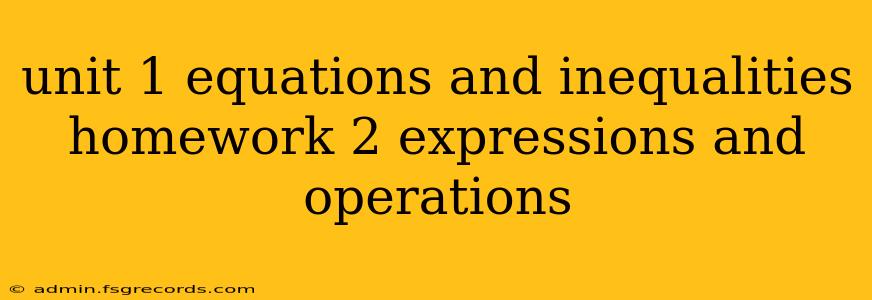This guide delves into the core concepts of expressions and operations, crucial components of Unit 1: Equations and Inequalities. We'll cover simplifying expressions, order of operations (PEMDAS/BODMAS), and working with different types of expressions, ensuring you're well-prepared for your homework.
Understanding Mathematical Expressions
A mathematical expression is a combination of numbers, variables, and operators (+, -, ×, ÷) that represents a mathematical quantity. Unlike equations, which have an equals sign (=), expressions don't necessarily represent a single value; they represent a calculation to be performed. For example, 3x + 5 is an expression, whereas 3x + 5 = 11 is an equation.
Types of Expressions
We encounter several types of expressions in algebra:
- Algebraic Expressions: These contain variables (letters representing unknown values) and constants (numbers). Examples include
2x + 7,y² - 4, and3ab + 2c. - Numerical Expressions: These contain only numbers and operators. An example is
12 + 6 ÷ 2. - Polynomial Expressions: These are algebraic expressions involving variables raised to non-negative integer powers. Examples are
x² + 2x + 1(quadratic) andx³ - 5x + 2(cubic).
Order of Operations (PEMDAS/BODMAS)
The order of operations dictates the sequence in which we perform calculations within an expression to ensure a consistent and correct result. The acronyms PEMDAS and BODMAS are commonly used:
PEMDAS:
- Parentheses (Brackets)
- Exponents (Orders)
- Multiplication and Division (from left to right)
- Addition and Subtraction (from left to right)
BODMAS:
- Brackets
- Orders
- Division and Multiplication (from left to right)
- Addition and Subtraction (from left to right)
Both acronyms represent the same order of operations. Let's illustrate with an example:
10 + 5 × 2 - (3 + 1)²
- Parentheses/Brackets: (3 + 1) = 4. The expression becomes
10 + 5 × 2 - 4². - Exponents/Orders: 4² = 16. The expression becomes
10 + 5 × 2 - 16. - Multiplication and Division: 5 × 2 = 10. The expression becomes
10 + 10 - 16. - Addition and Subtraction: 10 + 10 = 20; 20 - 16 = 4. The final answer is 4.
Simplifying Expressions
Simplifying expressions involves combining like terms and applying the order of operations to reduce the expression to its simplest form. Like terms are terms with the same variable raised to the same power. For instance, in 3x + 2y + 5x, 3x and 5x are like terms.
Example: Simplify 4x + 7 + 2x - 3
- Combine like terms:
(4x + 2x) + (7 - 3) - Simplify:
6x + 4
Working with Different Operations
Understanding how to perform addition, subtraction, multiplication, and division with both numbers and variables is essential. Remember:
- Addition and Subtraction: Combine like terms.
- Multiplication: Use the distributive property (a(b + c) = ab + ac).
- Division: Distribute the division to each term in the numerator if possible.
Practice Problems
To solidify your understanding, try these practice problems:
- Simplify:
5y - 2 + 3y + 8 - Evaluate:
20 ÷ 4 + 3 × 6 - 2² - Simplify:
3(x + 2) - 4x - Evaluate:
(15 - 5) ÷ 2 + 10
By mastering these concepts, you'll build a solid foundation for tackling more complex equations and inequalities in the following units. Remember to practice regularly and seek help when needed. Good luck with your homework!

